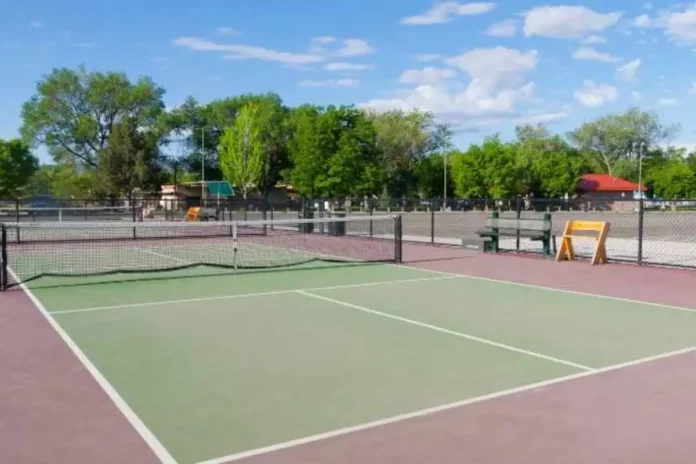Why New England’s Pickleball Dreams Are Crumbling: As winter sets in across New England, the region’s pickleball players are left grappling with a shortage of indoor pickleball facilities. The relentless cold, coupled with a dense population and limited outdoor court availability, creates an environment suitable for an increase of indoor pickleball options. However, the anticipated surge in investments has yet to materialize.
Demand Versus Reality: The Case of Massachusetts
Massachusetts shows the struggle, facing one of the highest demands for indoor pickleball courts in the country. Yet, this demand is stifled by a combination of real estate costs, regulatory hurdles, and the region’s unforgiving climate. “Massachusetts has a longstanding tradition of supporting community-centered sports.” says Dustin DeMeritt, co-founder of Pickles New England.
“Whether it’s youth leagues, adult sports clubs, or family-focused centers, New Englanders prioritize recreational activities that bring people together.” – (Dustin DeMeritt)
Despite the region’s affinity for recreational activities that creates community engagement, the lack of dedicated, weatherproof pickleball facilities shows a significant shortfall. Nearly 22% of Massachusetts residents are aged 55 or older, a demographic that gravitates toward pickleball for its social and physical benefits.
“Our member base at Pickles grew to over 8,000 players, showing just how significant the demand for year-round pickleball is in New England.” – (Dustin DeMeritt)

High Costs and Limited Options
The harsh reality of New England’s commercial real estate landscape poses a daunting barrier. With some of the highest property costs in the nation, areas like Boston and its suburbs make it difficult for recreational businesses to find affordable space.
“The initial investment is high, and you have to be certain that you can generate the revenue to cover operations while still keeping memberships affordable.” – (Dustin DeMeritt)
As a result, multi-use outdoor community courts dominate the local pickleball scene, supplemented by a handful of indoor options found at tennis clubs and YMCAs. Most dedicated pickleball clubs in New England operate on a membership model designed to balance affordability and profitability amid high operational costs.
Seasonal Challenges and Player Needs
New England’s winters, which can stretch from November to March, further complicate matters. Indoor facilities are not just an option; they are essential for sustaining player engagement throughout the year.
“When we started Pickles, we knew we had to be open year-round to meet the needs of dedicated players.” – (Dustin DeMeritt)
These indoor spaces offer a refuge from the cold, allowing players to remain active and connected during the harsh winter months. In contrast, facilities in warmer climates enjoy a steadier flow of traffic, side-stepping the financial burdens associated with heating and winter adaptations. For clubs in New England, maintaining an environment that accommodates peak winter demand while being cost-effective year-round is a significant challenge.
“Indoor facilities in New England don’t just provide a place to play—they’re a sanctuary from the cold, a way to stay active and connected through the harshest months.” – (Dustin DeMeritt)
Infrastructure Issues and Limited Opportunities
New England’s aging infrastructure presents difficulty. Many available commercial properties are ill-suited for conversion into indoor sports facilities.
“Newer buildings with clear-span structures and higher ceilings are ideal for indoor pickleball.” – (Dustin DeMeritt)
However, such spaces are rare in Massachusetts, and reconstructing older structures can lead to high renovation costs.
“But in Massachusetts, finding a space with enough square footage and high ceilings is rare, and retrofitting older buildings often means extremely high renovation costs.” – (Dustin DeMeritt)
This situation contrasts with newer developments in southern and western states, where converting suitable buildings is more straightforward. Even when potential sites exist, the financial implications of renovations for heating, ventilation, lighting, and accessibility significantly restrict the development of new pickleball facilities.
Community Spirit and Expectations
Despite the challenges, New England’s robust community spirit has spurred organic growth for pickleball.
“People here are loyal to local businesses, and there’s a real sense of pride in supporting neighborhood institutions. At Pickles, our members felt invested in the success of the club, and that sense of ownership helped us grow our membership without relying solely on marketing.” – (Dustin DeMeritt)
At Pickles, this community investment has been pivotal in expanding membership without relying solely on marketing. However, the high expectations that come with this community loyalty create pressure for new facilities. Establishing trust and a sense of belonging is crucial in these tight-knit areas.
Managing Regulatory Roadblocks
In addition to financial and logistical hurdles, prospective pickleball facilities in New England must handle a complex web of zoning and bureaucratic regulations. In states like Texas and Florida, streamlined processes promote rapid development of recreational spaces.
Conversely, Massachusetts can require multiple permits, community assessments, and consultations—lengthy and costly obstacles that can deter potential investors.
The Road Ahead for Indoor Pickleball
Despite these considerable challenges, the demand for indoor pickleball in New England remains unshaken. While the current number of indoor courts in Massachusetts and neighboring states is limited, innovative strategies such as partnerships with existing fitness centers and pop-up courts could pave the way for growth.
For now, established facilities like Pickles serve as crucial lifelines for the most dedicated players, offering year-round access to the nation’s fastest-growing game. As interest in pickleball continues to swell, the prospect for more indoor facilities in this challenging environment may finally be on the horizon.
News in Brief: Why New England’s Pickleball Dreams Are Crumbling
The Northeast faces a critical shortage of indoor pickleball facilities due to high real estate costs, seasonal climate challenges, and regulatory hurdles. In Massachusetts, where demand for pickleball courts is soaring, only a few dedicated spaces exist.
Community loyalty has fueled growth, but new facilities must establish trust to thrive. Despite obstacles, the future of indoor pickleball in the region shows potential for innovative solutions to meet players’ needs.
ALSO READ: New Pickleball Courts Coming to Natick Mall: But Who Is Joining Forces?

